Exploring the Winter Deserts
Part 5: Relaxing in South Africa’s Western Cape
Tuesday morning, we awoke to a dreary view as it had rained during the night. Lucky for us, we have a fully stocked kitchen for breakfast and got familiar with what would be “our space” for the next week. The management restocks basics daily, (including eggs, bacon, and all condiments), and also delivers fresh baguettes and croissants to our door promptly at 7:30am. After breakfast, we did a load of laundry, made a meager grocery list, and walked to the local grocery to plan a lamb chop dinner, before exploring the nearby beach, all in spite of the rain. That afternoon, we drove to the nearest liquor/wine store to top-off our stock, (Camp’s Bay does not allow packaged alcohol sales, so we needed to head along the beach to the next town, Sea Point).
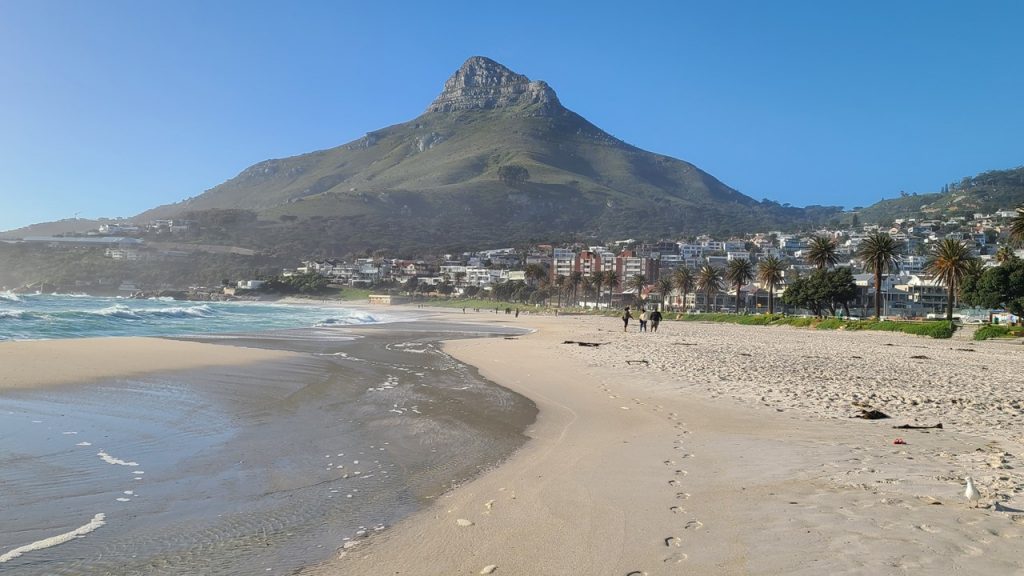
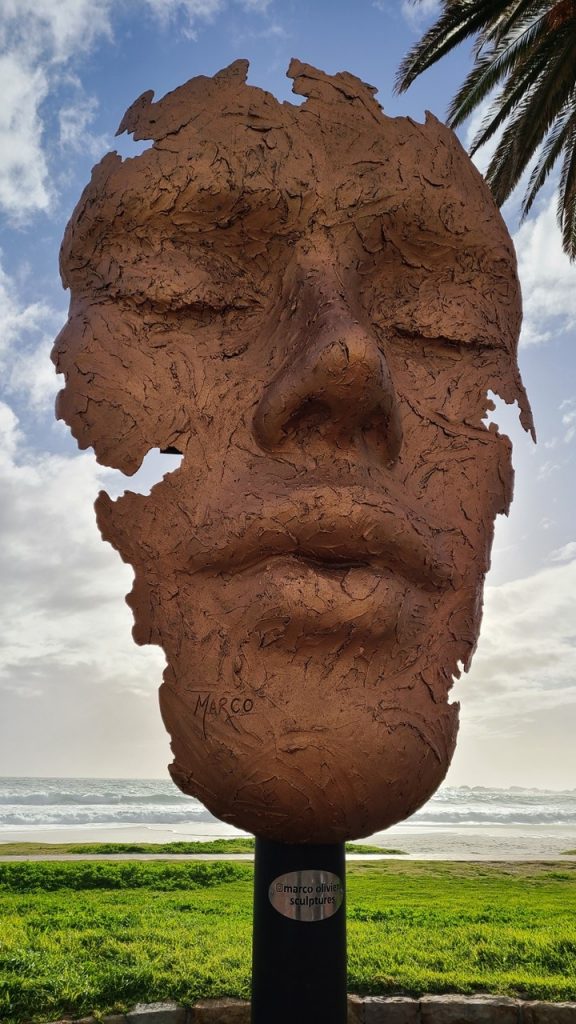
The next morning, after breakfast, we drove to Stellenbosch – wine country – as we hoped to visit a few wineries that day. We started with Warwick Estates – set in a group of old, white-washed buildings. This is an historic farm with a coffee house and restaurant, as well as daily wine tastings. There are no crowds, as it is winter in the southern hemisphere. Here we decided to taste the “First Lady” line of wines. We started with a sparkling rose, (the “Cape Classic”), which was very nice, then a dry Rose wine, a Sauvignon Blanc, a Chardonnay, and a Pintotage (developed from hybrid grafting a Pinot Noir vine with a Hermitage vine). Pintotage wines are now a preferred blend from this area of South Africa and it was very nice. Finally, we finished with a Cabernet Sauvignon. As were tasting we were told the legend of “The Wedding Cup” which revolves around the beautiful princess, Kunigunde. She was the daughter of the King and Queen of old Nuremberg, whose hand was promised in marriage to a prince from a faraway kingdom. However, the princess wanted to marry a local, so he was challenged to build a wedding cup for her that they could both drink from at the same time. He successfully constructed one thus winning her father over and allowing her to marry her love. As we were leaving we met two women who were in the wine courier business, and who recommended we next go the Muratie Wine Estate and try their port.
So, based upon their recommendation, we visited the Muratie Wine Estate next and ordered a cheese plate. Soon, the 2 women who recommended we come here for the port showed up and joined us. However, the port had apparently become so popular that it had been removed from the tasting list. But, because these women were wine couriers, we were all promised a tasting. Muratie Wine Estate is a very old winery which has windows full of ancient, preserved cobwebs, which have been there for years. Even with the generational change in owners, the spider webs and old calendars on the wall have been left “as is”. Finally, we decided on the Premium Tasting options that included the “Lady Alice” (a sparkling Pinot Noir which was very nice), the “Lauren’s Camphor” (a white blend), the “Isabella” (a Chardonnay), the Mr. May (a Grenache Noir), the “Martin Merck” (a Cabernet Sauvignon), and lastly the port which we were promised, and which was quite lovely.
After this lunch, we drove to Beyerskloof which is considered “the home” of Pinotage wines. It is a young winery (only about 30 years old) and was not far from Muratie. After a tasting of a few Pinotage, including the Pinotage Rose, Pinotage 2021, Cabernet Sauvignon, and a Reserve Pinotage, we chose our favorite and carried on to the next vineyard. Next, we went to Simonsig – the home of sparkling wines. Rocky tasted several whites (Chenin Blanc, Sauvignon Blanc, and a Chardonnay), and a couple of reds (a Pinotage, and Cabernet Sauvignon), while Julie tasted several sparkling wines (a Cuvée, a Vonkel Brut, a Brut Rose, a Satin Néctar and a Satin Néctar Rose). After Simonsig, it was late afternoon and we moved on to Rust en Vrede Vineyards, which was recommended to us by some other travelers. It was a very old vineyard that had been modernized in the 1970’s with white washed buildings and a wonderful view. Here we did a tasting of the Estate Syrah, the Estate Cabernet Sauvignon, and the Estate 2020. This vineyard actually has solar panels on their roofs which supply 40% of their power, which is useful in a country that has rolling power rationing. Upon returning to Camps Bay it was time for a light dinner and a relaxing evening.

The next morning, we had breakfast before setting off northwest along the coastal road 2-hours to the village of Paternoster. Along the route, as we left the city behind, we saw farms and several nature reserves as well as the West Coast National Park. Across the landscape, we saw impalas, dik-diks, ostriches, and a few zebras. There was also an Air Force Base, sheep and cattle farms, and a massive windmill farm. Here, the landscape was green, with only a few sandy-colored dunes. Paternoster is on the ocean on a large, secluded bay, and consists of a small village of white washed cottages with blue shutters and roofs. It is often described as South Africa’s most beautiful village. It has a long wide isolated beach with large rocks at each end for protection from the surf. Paternoster means “Our Father” and was named such by shipwrecked Portuguese sailors. Hundreds of ships have shipwrecked in South Africa’s dangerous West Coast coastline over the years.
When we arrived at the beach, we were greeted by boys trying to sell us fresh mussels. We walked the long, secluded, pristine beach, past mussel-covered rocks and enjoyed the quiet and peacefulness. There was no trash and only a few mussel shells on the shore. As it was winter, there were very few people out and about. However, there was a red-roofed building on the beach, which you could see from everywhere. It is the Voorstrand Restaurant. There we met a man throwing his dog a ball and as we spent time talking, the dog kept bringing Rocky his ball to throw. He told us that the restaurant would be open later for lunch. We returned to our car and drove around the village. As it was winter-time, a lot of businesses were closed or renovating, or were on holiday. It was chilly out, but the sun was shining and the people were friendly and hospitable. We checked the local hotel to see its famous “panty bar”, but the bar was not open. The local art galleries were also closed but a few souvenir shops were open and we visited and shopped. The town started to come to life around 2pm, and we went back to the Voorstrand Restaurant for lunch. It was not a big place but they have a large, covered patio on the beach with a great view, so we ordered gumbo, a hake fish plate, and a snack plate with mussels, prawns, samosas, calamari, and oysters. It was a feast, the food was delicious, and the atmosphere was the best. By the time we left, the restaurant was full of guests – a very enjoyable lunch. Eventually, we headed back to Camps Bay.

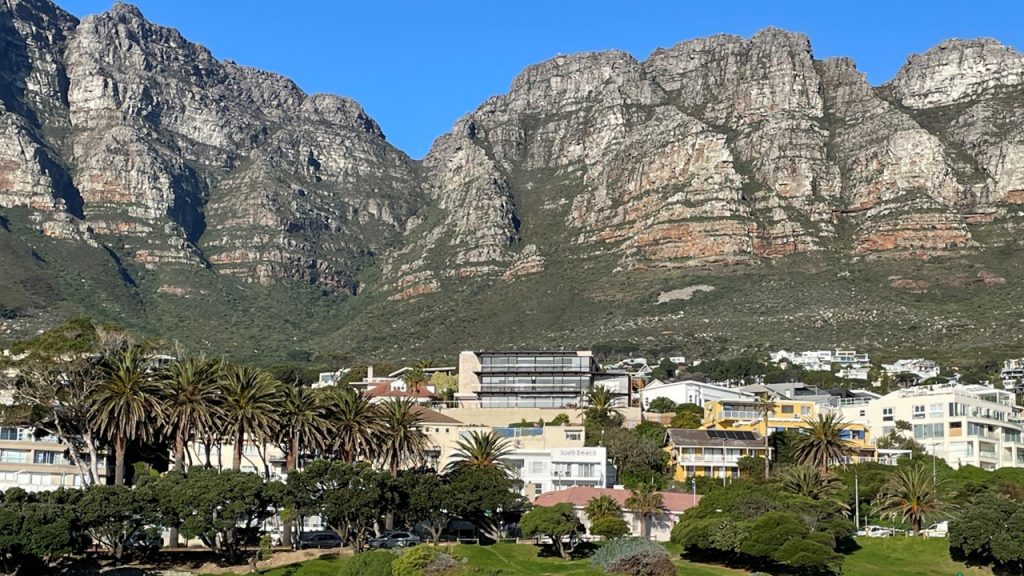
Once back to Camps Bay we walked along the beach and then enjoyed sundowners at the hotel’s pool deck. The night’s special drink was a “Plumosa” (tequila, grapefruit/lemon juice and sparkly wine) which was very refreshing. The pool was heated but since it was winter, no one was swimming.
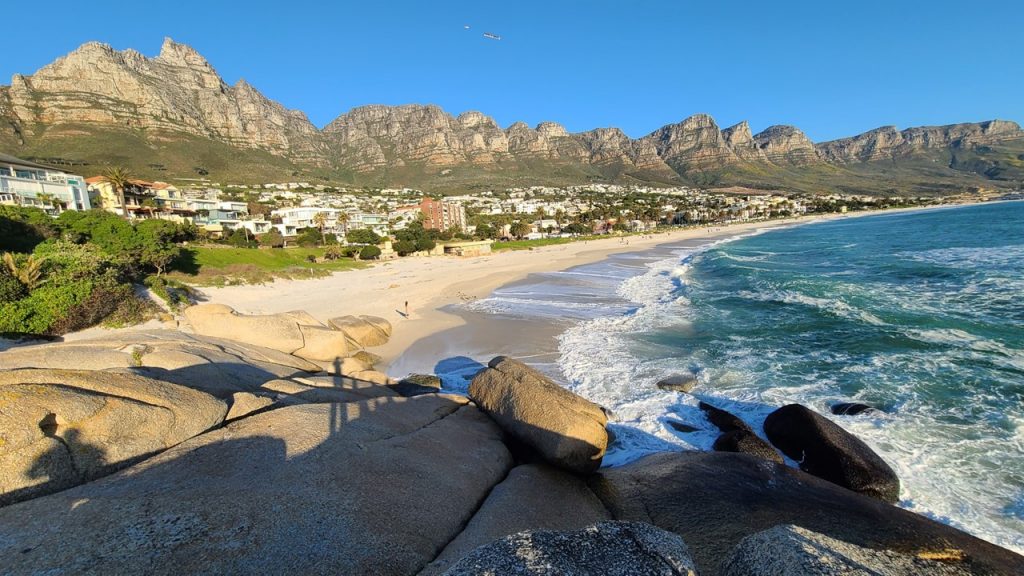
The next day we drove the Beach Road to The Victoria and Albert Waterfront, specifically to the V&A Wharf Shopping Center. It is a three-story mall with parking underground, with a major grocery store on the ground level, and retail stores above. We window-shopped for a while before heading out onto the wharf. Along the wharf, we walked among old warehouses that had been converted to shops. There were also sightseeing boats that one could book, and lots of restaurants. But this is also a working wharf with drydocks and marine yards scattered among the tourists, with boats going to Robbin Island, boats being repaired, and with wharf improvements all taking place. We went to the clock tower, and saw seals swimming in the dock area near the ferries. We finally stopped at Quay 4 for lunch having gumbo and the best fish and chips ever! Rocky ordered a Castle beer and received the beer with a scratch off card for a “beer lottery” chance! However, his card said “Sorry”! We eventually found some souvenirs before heading back along the Beach Road to our place at Camps Bay. Later that afternoon, we took a walk on the beach looking for beach glass and watching the local youth team practice their rugby skills.
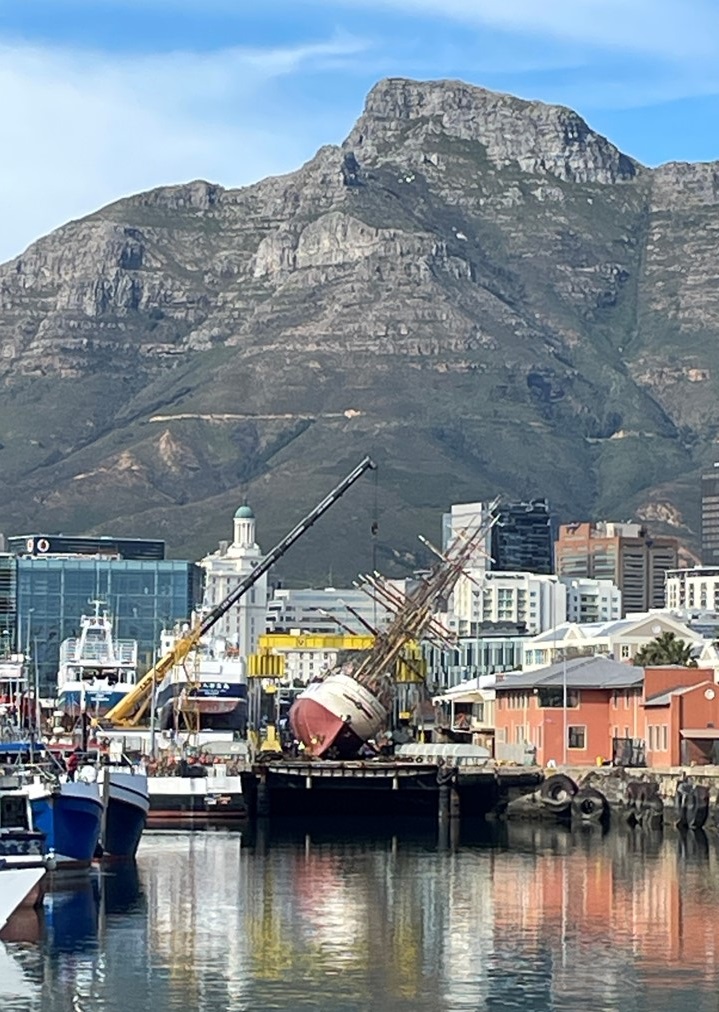

Saturday morning, after breakfast, we decided to drive around Table Mountain to the Boulders Penguin Colony located about an hour away on the East Coast of South Africa. This colony of African Penguins live in a sheltered cove of massive boulders and within a dense thicket of mangroves in a residential area south of Simon’s Town. The African Penguin once numbered 1.5 million (in 1910) but was down to just 2-breeding pairs by 1982. The uncontrolled harvesting of penguin eggs and commercial fishing nearly drove them to extinction. However, once pelagic trawling was eliminated in False Bay, an increase in the pilchards (herring) and anchovies supply helped the penguin population recover. The penguins are now part of Table Mountain National Park and the area is full of thick brush for nesting and recent estimates put the population of penguins at 2200-2500 – significantly larger than our during our last visit here 13-years ago. We saw penguins nesting in holes and under bushes, sheltering their downy newborns. There were also young juveniles – the “blue” baby blues – so named because when they lose their baby down, it is replaced with an initial waterproof, dark blue-grey plumage. There were large groups of penguins on the dunes and other groups in and out of the water. There were many swimming to a large flat top rock offshore and then hopping to the top of the rock for a little sun before coming back to shore. One of their biggest enemies is the Kelp Gull, which likes to steal the eggs and attack very young chicks. We walked the boardwalks at Foxy Beach watching enjoying the penguins’ antics. We also climbed some of the large Boulders at Boulders Beach. Afterwards, we drove the beach road south to Miller’s Point where we spotted a whale out in the surf, occasionally surfacing – just like we had seen during our visit here 13 years ago. Our drive back to Camps Bay took us along the beach road through Simone’s Town then Houk Bay before crossing over and around the edge of Table Mountain. Once in Camps Bay we headed to a restaurant named “Primi” for a late lunch of zucchini sticks, pizza, and wine.

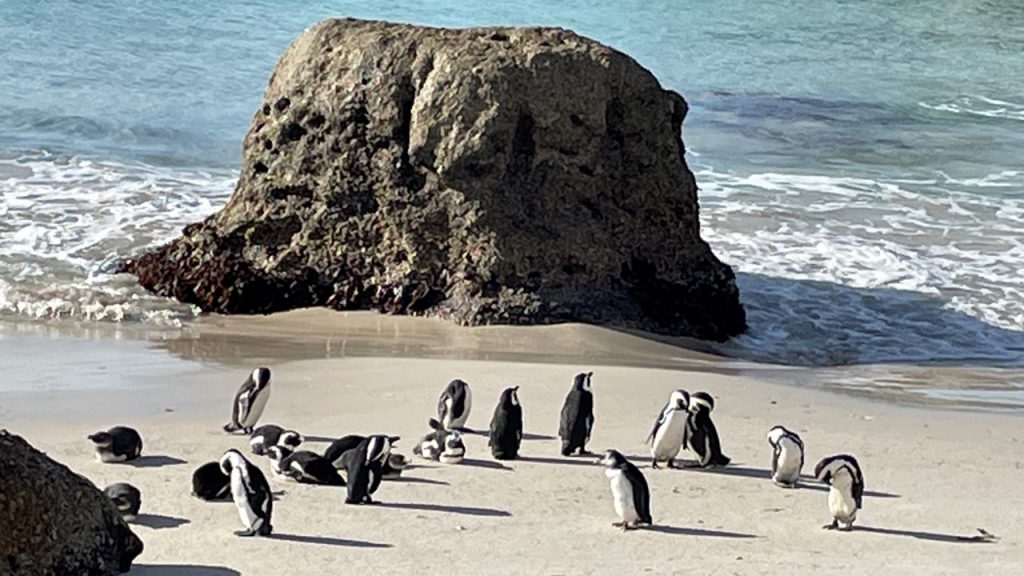
Sunday morning after breakfast, we decided to take a leisurely drive and head to a very historic area called “Constantia”, where there were lots of older residences with a bit of land, as well as a few local wineries. We went to see the “Groot Constantia Wine Estate” which was founded in 1685 by Jan van Riebeeck who had been sent here to establish a “replenishment station” for ships heading to the Far East. Instead, he started a vineyard. Fast forward to 1792 when the first restoration took place, and then to 1885 when the estate was sold in public auction to the government. In 1925 there was another major restoration due to a fire, and this time it was meticulously restored. Finally, the government turned over the farm/estate (~170 hectares) to a private trust in 1993. Since then it has been run as a profit-making business with the grounds open to the public. As we entered the gates we saw people walking and jogging among the vineyard groves, as well as numerous people heading to the two different restaurants on the grounds for Sunday coffee, hot chocolate, donuts, or a full breakfast. There were children in the yards playing ball and families feeding the ducks in the ponds. The buildings (the Manor House, the Vineyards, the Cellars, and Gift Shop) were all open and busy. We heading to the tasting room, which was very quiet at this early hour, and settled on a 5 wine tasting, including a Sauvignon Blanc, a Rose, and several reds. We really enjoyed the Cabernet Sauvignon 2020, and the Gouverneur’s Reserve (red) 2019. We had an excellent wine guide, Abram, who was a delight to converse with and very knowledgeable and curious. We also had the opportunity to taste the Grand Constance 2018, a lovely sweet but smooth desert wine. We finished the morning purchasing the desert wine and parting with 2 wine glasses as a gift and memory of the day.
Monday would be our last day in South Africa and we started with a leisurely breakfast. Our suite has a 2-burner stove, an oven/microwave, a fridge, and freezer, with the fridge being fully stocked daily, (eggs, bacon, salmon, cheese, fruits, OJ, almond milk, yogurt, granola, etc.), plus fresh croissants and baguettes. We have gotten very spoiled. We completed our final packing and loaded the luggage into the car’s boot. We checked out of our accommodations and said “goodbye” to Camps Bay – still one of our most favorite places to visit. We have a few hours, so we head to the world-renown “Kirstenbosch National Botanical Gardens”. It is probably one of the most spacious and beautiful gardens we have visited as it encompasses many different types of gardens, many of which are built into the eastern slopes of Table Mountain. They even boast a yellow version of the “bird-of-paradise” plant that was developed in honor of Nelson Mandela. After 2 1/2 hours visiting the conservatory, many, many gardens, and even an elevated canopy tree walk, it was time to head to the airport where we turned in the car and ran into teams of rugby players, teams of net ball players (as the Netball World Cup is going on in Cape Town), and other foreign travelers from England, Saudi Arabia, and the USA.
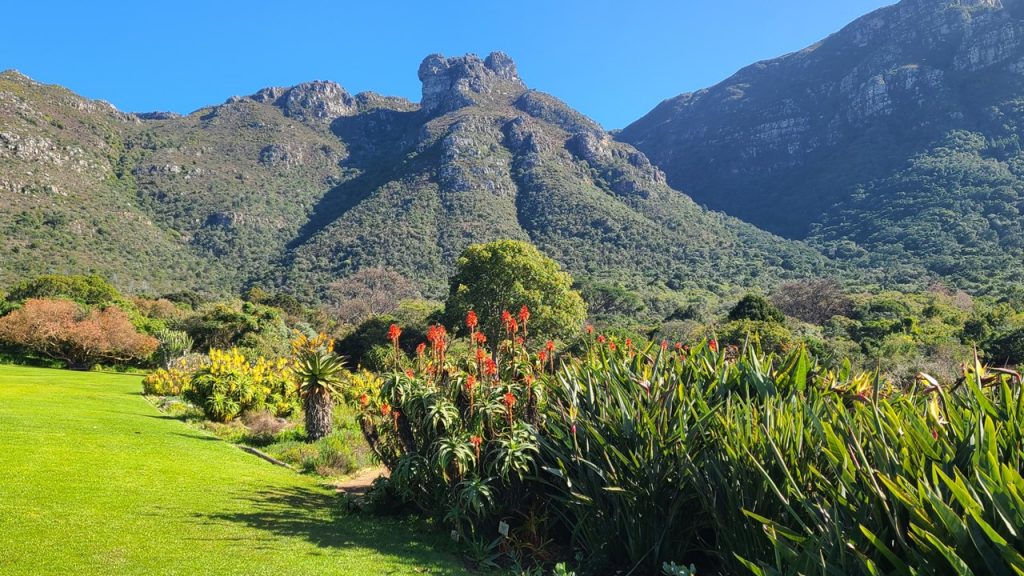
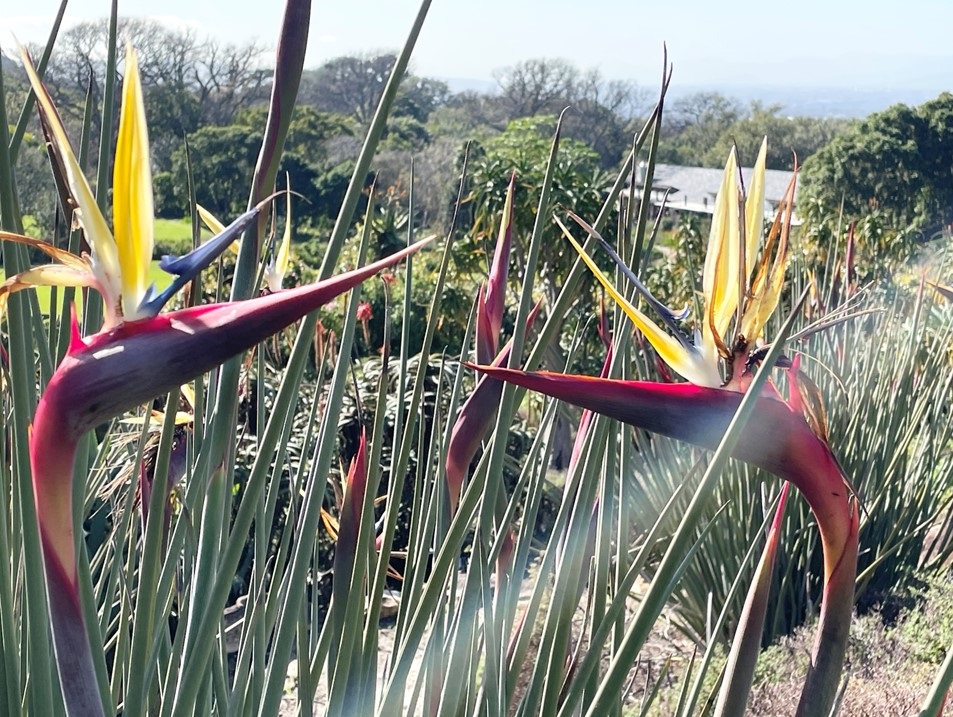
Our long flight home is uneventful as we return from another great African adventure..
